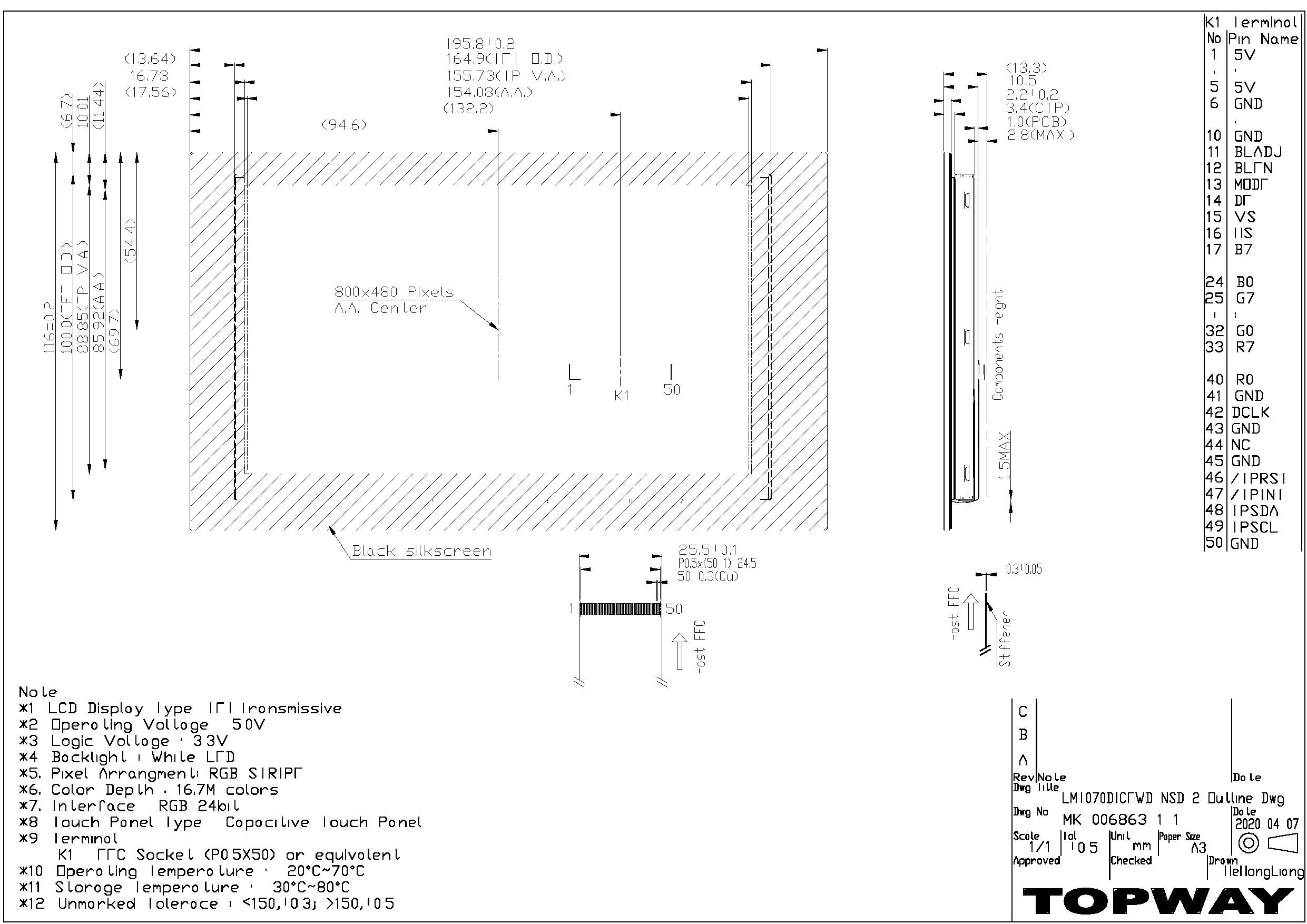
LMT070DICFWD-NSD-2
LCD Module User Manual
Prepared by:
Checked by:
Approved by:
Yurujie
Date: 2020-04-24
Date:
Date:
Rev. Descriptions
Edit
Release Date
0.1
Preliminary release
Yurujie
2020-4-24
URL: www.topwaydisplay.com
Document Name:LMT070DICFWD-NSD-2-Manual-Rev0.1.docx
Page: 1 of 22

TOPWAY
LCD Module User Manual
LMT070DICFWD-NSD-2
Table of Content
1. General Specification ........................................................................................................................... 3
2. Block Diagram ........................................................................................................................................ 3
3. Terminal Function (Input Terminal) .................................................................................................. 4
4. Absolute Maximum Ratings ................................................................................................................ 4
5. Electrical Characteristics ..................................................................................................................... 5
5.1 DC Characteristics ........................................................................................................................................................................... 5
5.2 Power Sequence .............................................................................................................................................................................. 5
6. AC Characteristics ................................................................................................................................. 6
6.1 Timing Characteristics ..................................................................................................................................................................... 6
6.2 Input Clock and Data Timing Diagram .......................................................................................................................................... 6
6.3 AC Timing .......................................................................................................................................................................................... 7
6.4 Data Input Format ............................................................................................................................................................................ 7
7. CTP Function Characteristics ............................................................................................................ 8
7.1 I 2 C Communication .......................................................................................................................................................................... 8
7.3 Data Transmission ........................................................................................................................................................................... 9
7.4 Register Information of CTP ......................................................................................................................................................... 10
8. Optical Characteristics ....................................................................................................................... 17
9. LCD Module Design and Handling Precautions .......................................................................... 18
10. CTP Mounting Instructions ............................................................................................................... 19
11. RTP Mounting Instructions ............................................................................................................... 20
12. Warranty ................................................................................................................................................. 22
URL: www.topwaydisplay.com
Document Name:LMT070DICFWD-NSD-2-Manual-Rev0.1.docx
Page: 2 of 22

TOPWAY
LCD Module User Manual
LMT070DICFWD-NSD-2
1. General Specification
Signal Interface :
Digital 24-bits RGB
Display Technology :
a-Si TFT active matrix
Display Mode :
TN Type Full Color / Transmissive / Normal White
Screen Size(Diagonal) :
7.0”
Outline Dimension :
195.8 x 116.0 x 13.3 MAX (mm)
(see attached drawing for details)
Active Area :
154.08 x 85.92 (mm)
Number of dots :
800 x 480
Pixel Pitch :
0.1926 x 0.179 (mm)
Pixel Configuration :
RGB Stripe
Backlight :
LED
Viewing Direction :
6 o’clock(Gray scale Inversion) (*1)
12 o’clock (*2)
Touch Panel Type:
Capacitive Touch Panel
Operating Temperature :
-20 ~ +70°C
Storage Temperature :
-30 ~ +80°C
Note:
*1. For saturated color display content (eg. pure-red, pure-green, pure-blue or pure-colors-combinations).
*2. For “ color scales ” display content.
*3. Color tone may slightly change by temperature and driving condition.
2. Block Diagram
/TPRST, /TPINT
TPSDA, TPSCL
Capacitive Touch Panel
R0~R7, G0~G7,B0~B7,
7’’ TFT Panel
DCLK, DE, HS,VS, MODE
BLADJ, BLEN
Backlight Circuit
+5V, GND
Power Circuit
URL: www.topwaydisplay.com
Document Name:LMT070DICFWD-NSD-2-Manual-Rev0.1.docx
Page: 3 of 22

TOPWAY
LCD Module User Manual
LMT070DICFWD-NSD-2
3. Terminal Function (Input Terminal)
Pin Pin
No. Name
I/O
Descriptions
1
5V
:
:
Power
5V power supply
5
5V
6
GND
:
:
Power
0V power supply
10
GND
11
BLADJ
Input
Backlight brightness PWM signal (active low)
12
BLEN
Input
Backlight enable signal (active high)
13
MODE
Input
when MODE = “1”: DE mode (default).
when MODE = “0”: SYNC mode, DE must be grounded.
14
DE
Input
Data Input Enable
15
VS
Input
Vertical sync signal
16
HS
Input
Horizontal sync signal
17
B7
:
:
Input
Blue data line
23
B1
Input
Blue data line(*1)
24
B0
Input
Blue data line(*1)
25
G7
:
:
Input
Green data line
31
G1
Input
Green data line(*1)
32
G0
Input
Green data line(*1)
33
R7
:
:
Input
Red data line
39
R1
Input
Red data line(*1)
40
R0
Input
Red data line(*1)
41
GND
Power
Ground, 0V
42
DCLK
Input
Pixel clock(*2)
43
GND
Power
Ground, 0V
44
NC
NC
No Connection
45
GND
Power
Ground, 0V
46
/TPRST
Input
Reset signal, active low reset
47
/TPINT
Output
Interrupt signal, active low interrupt
48
TPSDA
I/O
I2C data (*3)
49
TPSCL
Input
I2C clock (*3)
50
GND
Power
Ground
Note:
*1. When input 18bits RGB data, the two low bits of R,G and B data must be grounded.
*2. Data shall be latched at the falling edge of DCLK.
*3. With internal resister(4.7k) pull up.
4. Absolute Maximum Ratings
Items
Symbol
Min.
Max.
Unit
Condition
Power Voltage
V 5V
-0.3
+5.5
V
GND = 0V
Operating Temperature
T OP
-20
+70
℃
No Condensation
Storage Temperature
T ST
-30
+80
℃
No Condensation
Cautions:
Any Stresses exceeding the Absolute Maximum Ratings may cause substantial damage to the device. Functional
operation of this device at other conditions beyond those listed in the specification is not implied and prolonged exposure
to extreme conditions may affect device reliability.
URL: www.topwaydisplay.com
Document Name:LMT070DICFWD-NSD-2-Manual-Rev0.1.docx
Page: 4 of 22

TOPWAY
LCD Module User Manual
LMT070DICFWD-NSD-2
5. Electrical Characteristics
5.1 DC Characteristics
GND=0V, V 5V =5.0V, T OP =25 ℃
Items
Symbol
MIN.
TYP.
MAX.
Unit Applicable Pin
Power Voltage
V 5V
4.5
5.0
5.5
V
5V
Operating Current (*1)
I 5V
-
510
-
mA
Input High Voltage
V IH
3.0
-
3.6
V
Input pins
Input Low Voltage
V IL
0
-
0.3
V
Input pins
Output Signal High Voltage
V oH
3.0
-
3.6
V
Output Signal Low Voltage
V oL
0
-
0.6
V
Note:
*1. For different LCM, the value may have a bit of difference.
*2. To test the current dissipation, use “all Black Pattern”.
5.2 Power Sequence
Power on:
+5V → DATA → BLEN
Power off:
BLEN → DATA → +5V
Note :Data include R0~R7,B0~B7,G0~G7, DCLK, HS, VS, DE, MODE, /TPRST, /TPINT, TPSDA, TPSCL.
URL: www.topwaydisplay.com
Document Name:LMT070DICFWD-NSD-2-Manual-Rev0.1.docx
Page: 5 of 22

TOPWAY
LCD Module User Manual
LMT070DICFWD-NSD-2
6. AC Characteristics
6.1 Timing Characteristics
Item
Symbol
MIN.
TYP.
MAX.
Unit
Remark
HS setup time
Thst
8
-
-
ns
HS hold time
Thhd
8
-
-
ns
VS setup time
Tvst
8
-
-
ns
VS hold time
Tvhd
8
-
-
ns
Data setup time
Tdsu
8
-
-
ns
Data hole time
Tdhd
8
-
-
ns
DE setup time
Tesu
8
-
-
ns
DV DD Power On Slew rate
TPOR
-
-
20
ms
From 0 to 90%
DV DD
DCLK cycle time
Tcph
20
-
-
ns
DCLK pulse duty
Tcwh
40
50
60
%
Note: For the details of the timing, please see the Driver IC data sheet.
6.2 Input Clock and Data Timing Diagram
URL: www.topwaydisplay.com
Document Name:LMT070DICFWD-NSD-2-Manual-Rev0.1.docx
Page: 6 of 22
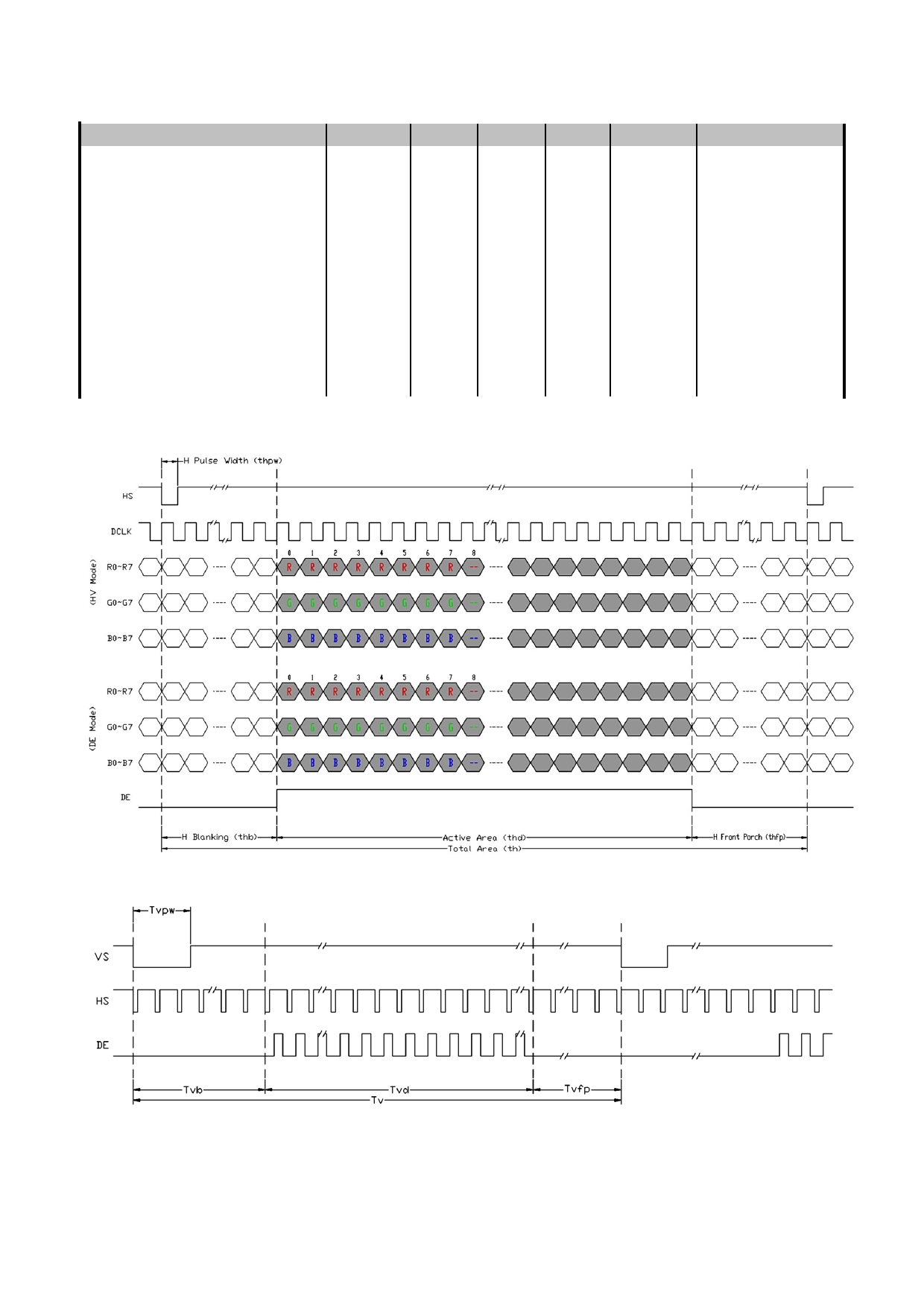
TOPWAY
LCD Module User Manual
LMT070DICFWD-NSD-2
6.3 AC Timing
Item
Symbol
MIN.
TYP.
MAX. Unit
Remark
Horizontal Display Area
thd
-
800
-
DCLK
DCLK Frequency
fclk
26.4
33.3
46.8
MHz
One Horizontal Line
th
862
1056
1200
DCLK
HS pulse width
thpw
1
-
40
DCLK
HS Blanking
thb
46
46
46
DCLK
HS Front Porch
thfp
16
210
354
DCLK
Vertical Display Area
tvd
-
480
-
TH
VS period time
tv
510
525
650
TH
VS pulse width
tvpw
1
-
20
TH
VS Blanking
tvb
23
23
23
TH
VS Front Porch
tvfp
7
22
147
TH
6.4 Data Input Format
Horizontal input timing diagram.
Vertical input timing diagram.
URL: www.topwaydisplay.com
Document Name:LMT070DICFWD-NSD-2-Manual-Rev0.1.docx
Page: 7 of 22
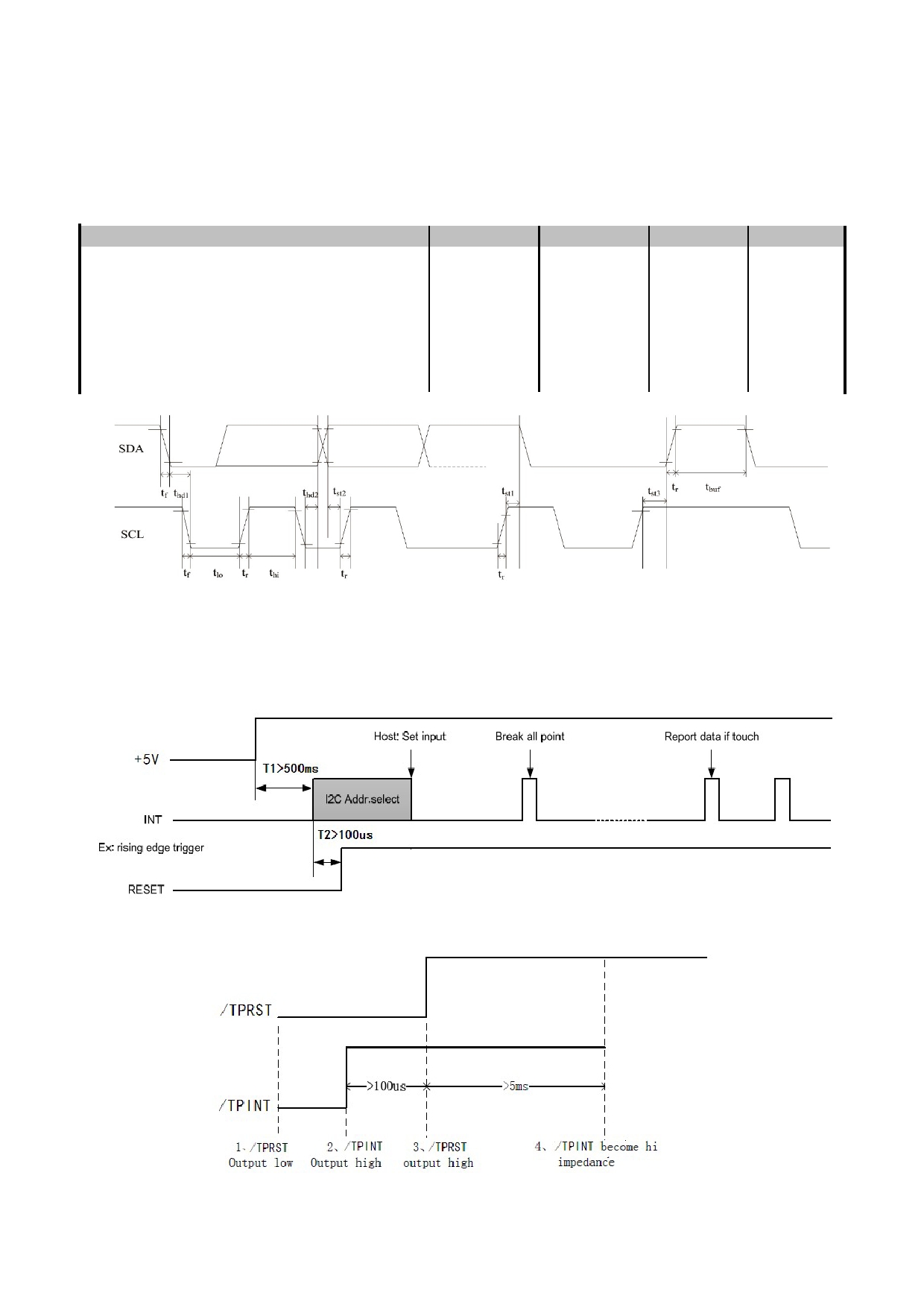
TOPWAY
LCD Module User Manual
LMT070DICFWD-NSD-2
7. CTP Function Characteristics
7.1 I 2 C Communication
CTP provides standard I 2 C interface for communication. In the system, CTP always works in slave
mode, all communications are initiated by master, and the baud rate can be up to 400Kbps. The
definition of I 2 C timing is as following:
Parameter
Symbol
Min.
Max.
Unit
SCL low period
t lo
1.3
-
us
SCL high period
t hi
0.6
-
us
SCL setup time for start condition
t st1
0.6
-
us
SCL setup time for stop condition
t st3
0.6
-
us
SCL hold time for start condition
t hd1
0.6
-
us
SDA setup time
t st2
0.1
-
us
SDA hold time
t hd2
0
-
us
I 2 C Timing
CTP has 2 sets of slave address 0xBA/0xBB & 0x28/29. Master can control Reset & INT pin to
configure the slave address in power on initial state like following:
7.2 Power on diagram:
Timing of setting slave address to 0x28/0x29:
URL: www.topwaydisplay.com
Document Name:LMT070DICFWD-NSD-2-Manual-Rev0.1.docx
Page: 8 of 22
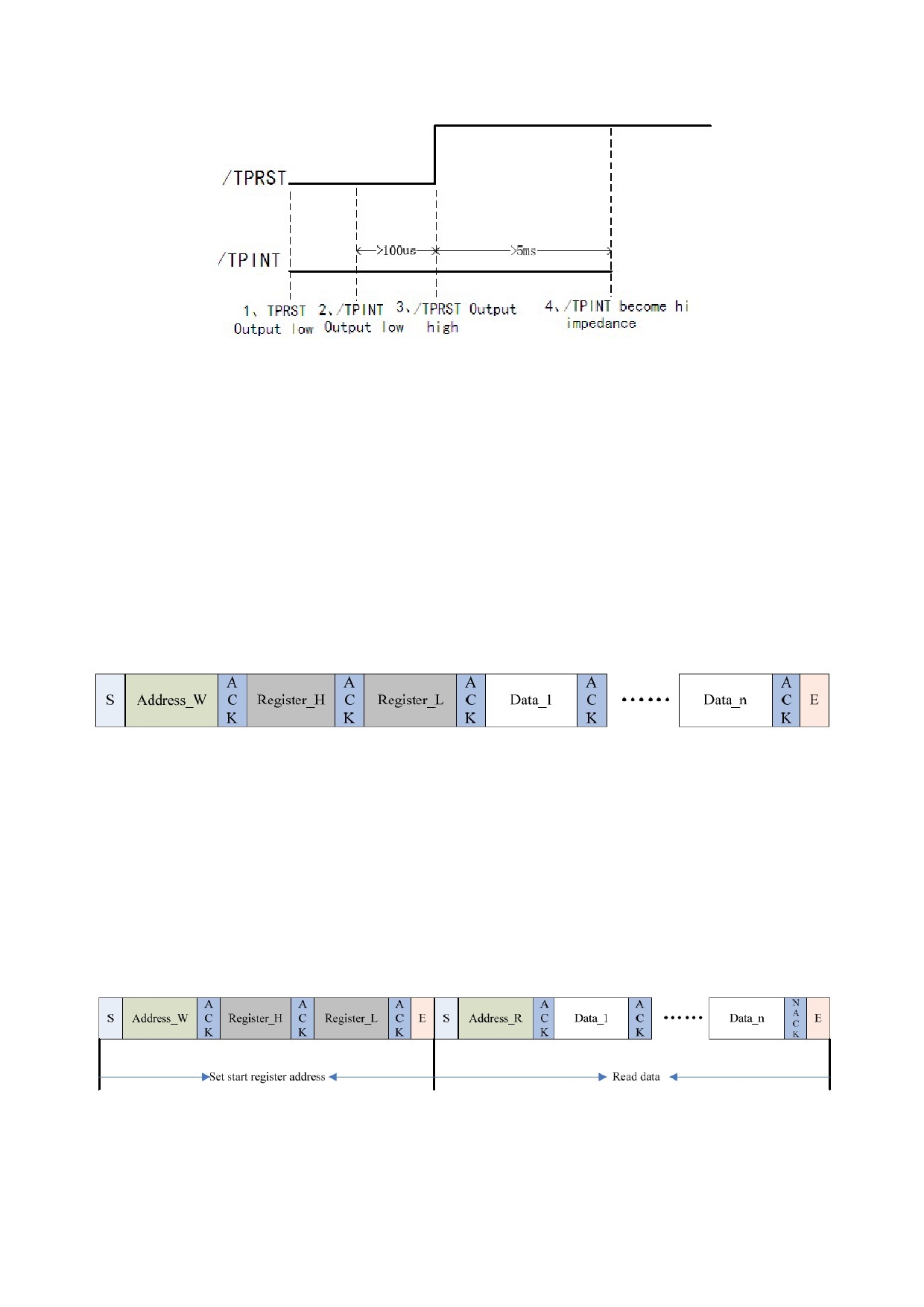
TOPWAY
LCD Module User Manual
LMT070DICFWD-NSD-2
Timing of setting slave address to 0xBA/0xBB:
7.3 Data Transmission
(ex: slave address is 0xBA/0xBB)
Communication is always initiated by master, A high-to-low transition of SDA with SCL high is a start
condition.
All addressing signal are serially transmitted to and from on bus in 8-bit word. CTP sends a“0” to
acknowledge when the addressing word is 0xBA/BB (or 0x28/0x29 ). This happens during the ninth
clock cycle. If the slave address is not matched, CTP will stay in idle state.
The data words are serially transmitted to and from in 9-bit formation: 8-bit data + 1-bit ACK or NACK
sent by CTP. Data changes during SCL low periods & keeps valid during SCL high.
A low-to-high transition of SDA with SCL high is a stop condition.
Write Data to CTP
Write Operations
Please check the above figure, master start the communication first, and then sends device address
0XBA preparing for a write operation.
After receiving ACK from CTP, master sends out 16-bit register address, and then the data word in 8-bit,
which is going to be wrote into CTP.
The address pointer of CTP will automatically increase one after one byte writing, so master can
sequentially write in one operation. When operation finished, master stop the communication.
Read Data from CTP
(ex: slave address is 0xBA/0xBB)
Read Operations
Please check the above figure, master start the communication first, and then sends device address
0xBA for a write operation.
After receiving ACK from CTP, master sends out 16-bit register address, to set the address pointer of
URL: www.topwaydisplay.com
Document Name:LMT070DICFWD-NSD-2-Manual-Rev0.1.docx
Page: 9 of 22
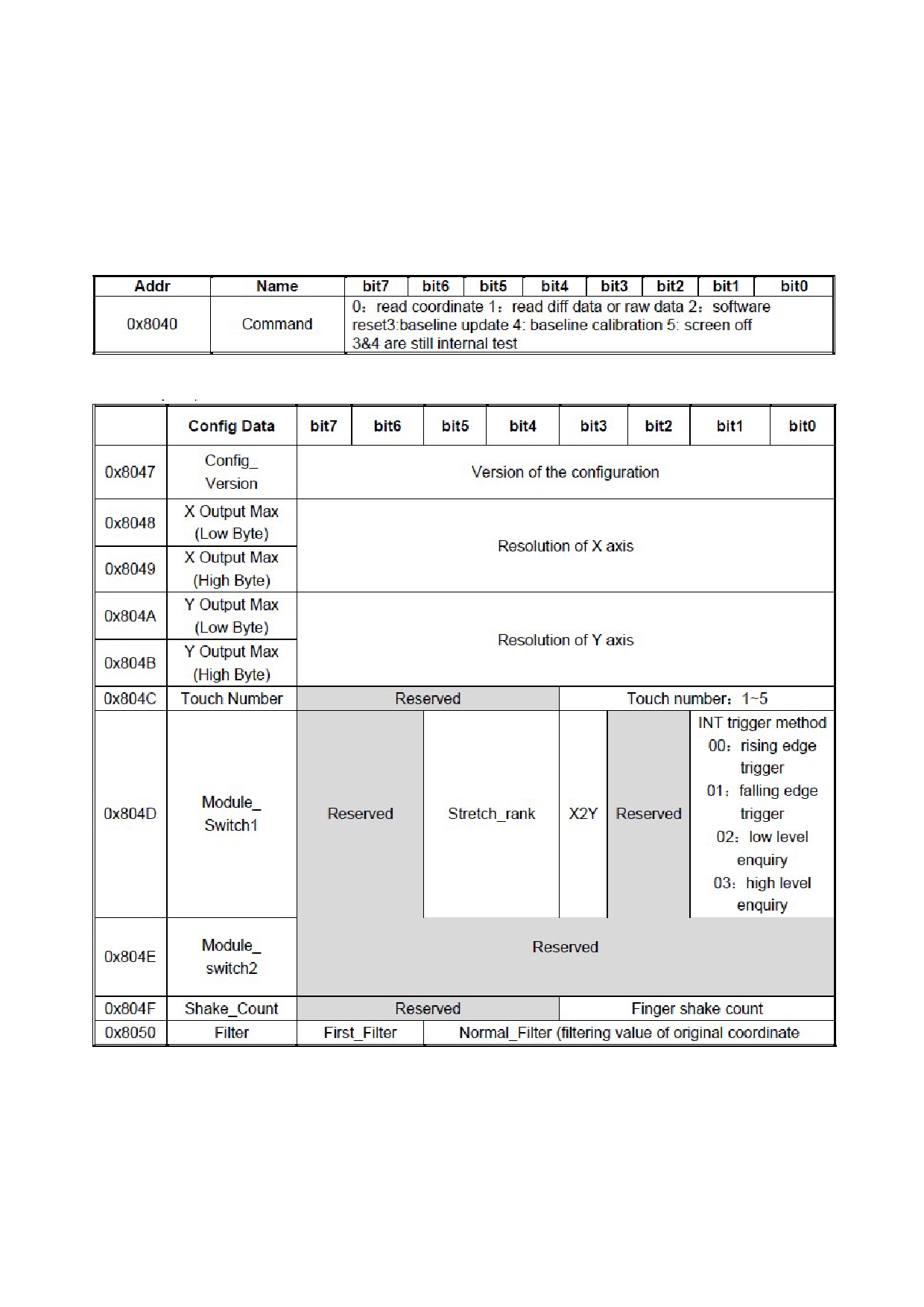
TOPWAY
LCD Module User Manual
LMT070DICFWD-NSD-2
CTP. After receiving ACK, master produce start signal once again & send device address 0xBB , then
read data word from CTP in 8-bit.
CTP also supports sequential read operation, and the default setting is sequential read mode.
Master shall send out ACK after every byte reading successfully but NACK after the last one.
Then sends stop signal to finish the communication.
7.4 Register Information of CTP
Real Time Order(Write Only)
Configuration Information(R/W)
URL: www.topwaydisplay.com
Document Name:LMT070DICFWD-NSD-2-Manual-Rev0.1.docx
Page: 10 of 22

TOPWAY
LCD Module User Manual
LMT070DICFWD-NSD-2
URL: www.topwaydisplay.com
Document Name:LMT070DICFWD-NSD-2-Manual-Rev0.1.docx
Page: 11 of 22
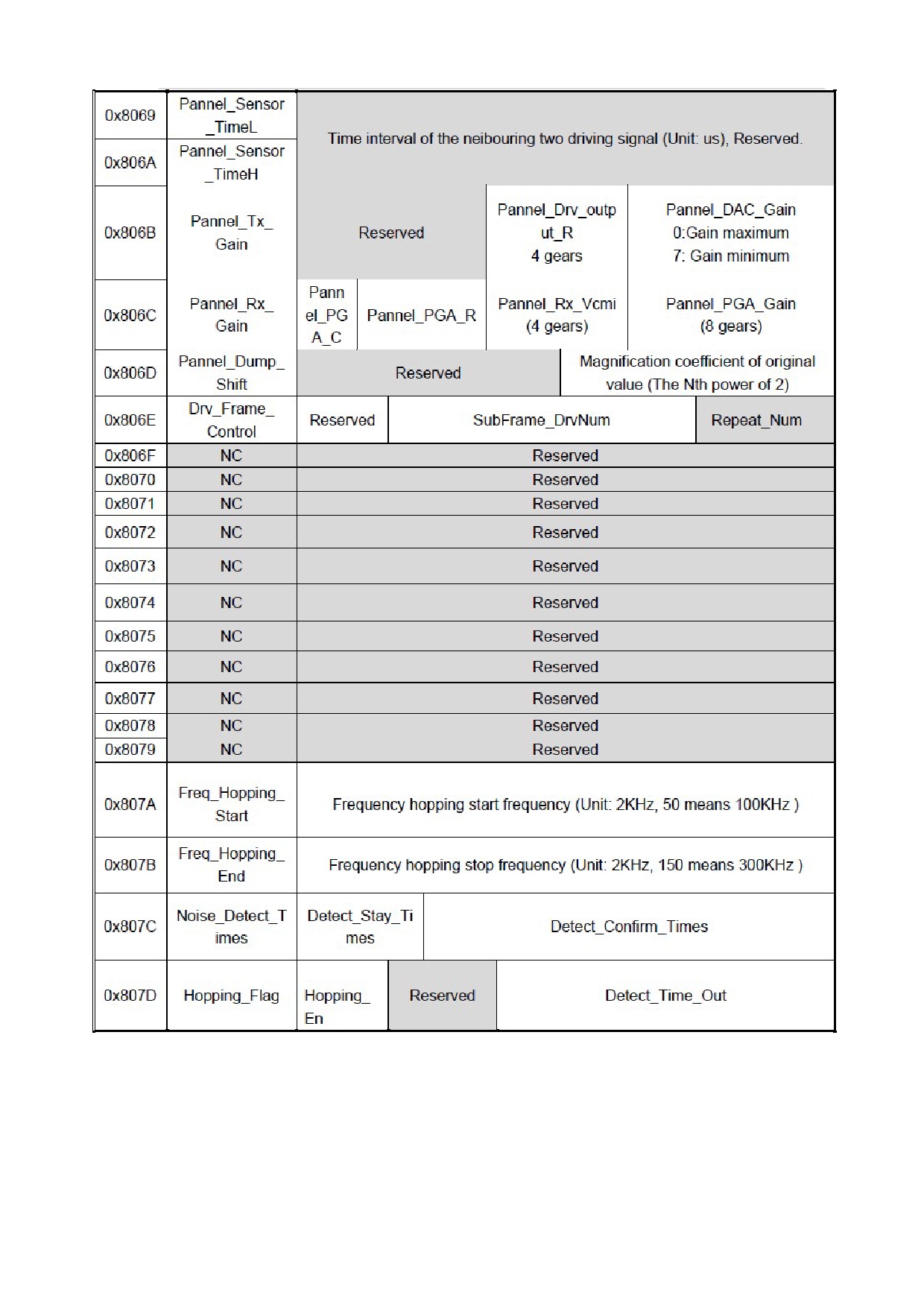
TOPWAY
LCD Module User Manual
LMT070DICFWD-NSD-2
URL: www.topwaydisplay.com
Document Name:LMT070DICFWD-NSD-2-Manual-Rev0.1.docx
Page: 12 of 22
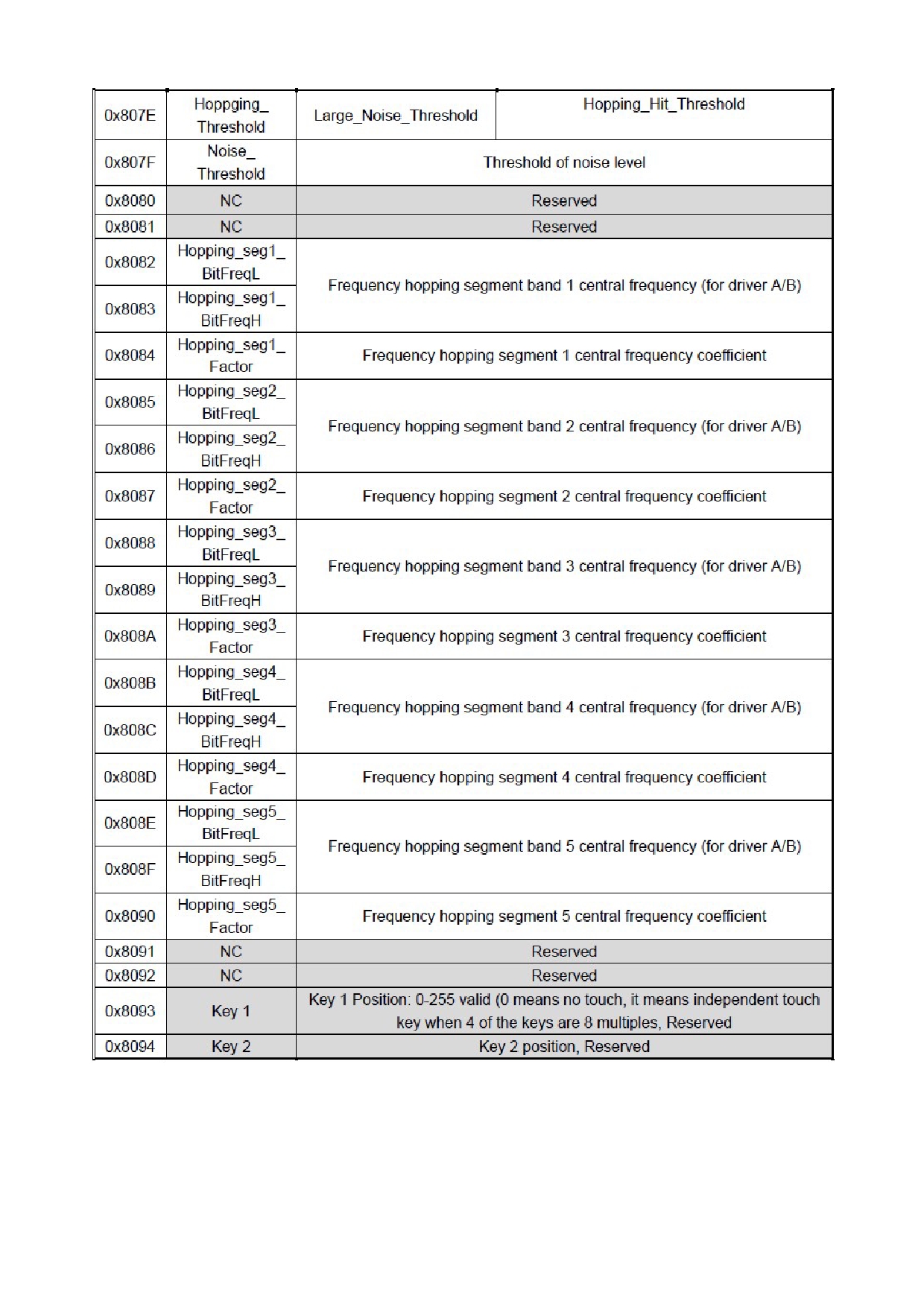
TOPWAY
LCD Module User Manual
LMT070DICFWD-NSD-2
URL: www.topwaydisplay.com
Document Name:LMT070DICFWD-NSD-2-Manual-Rev0.1.docx
Page: 13 of 22
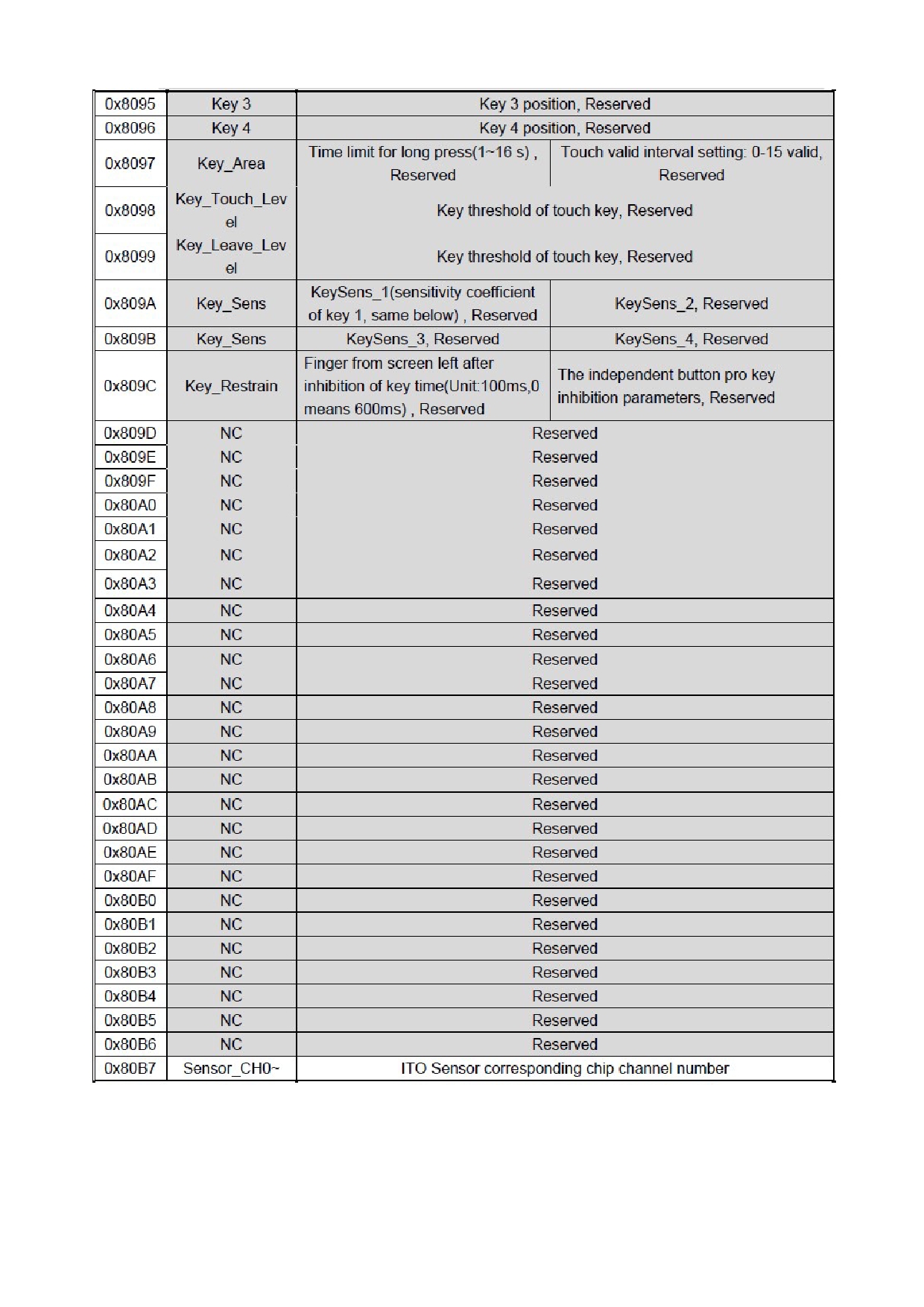
TOPWAY
LCD Module User Manual
LMT070DICFWD-NSD-2
URL: www.topwaydisplay.com
Document Name:LMT070DICFWD-NSD-2-Manual-Rev0.1.docx
Page: 14 of 22
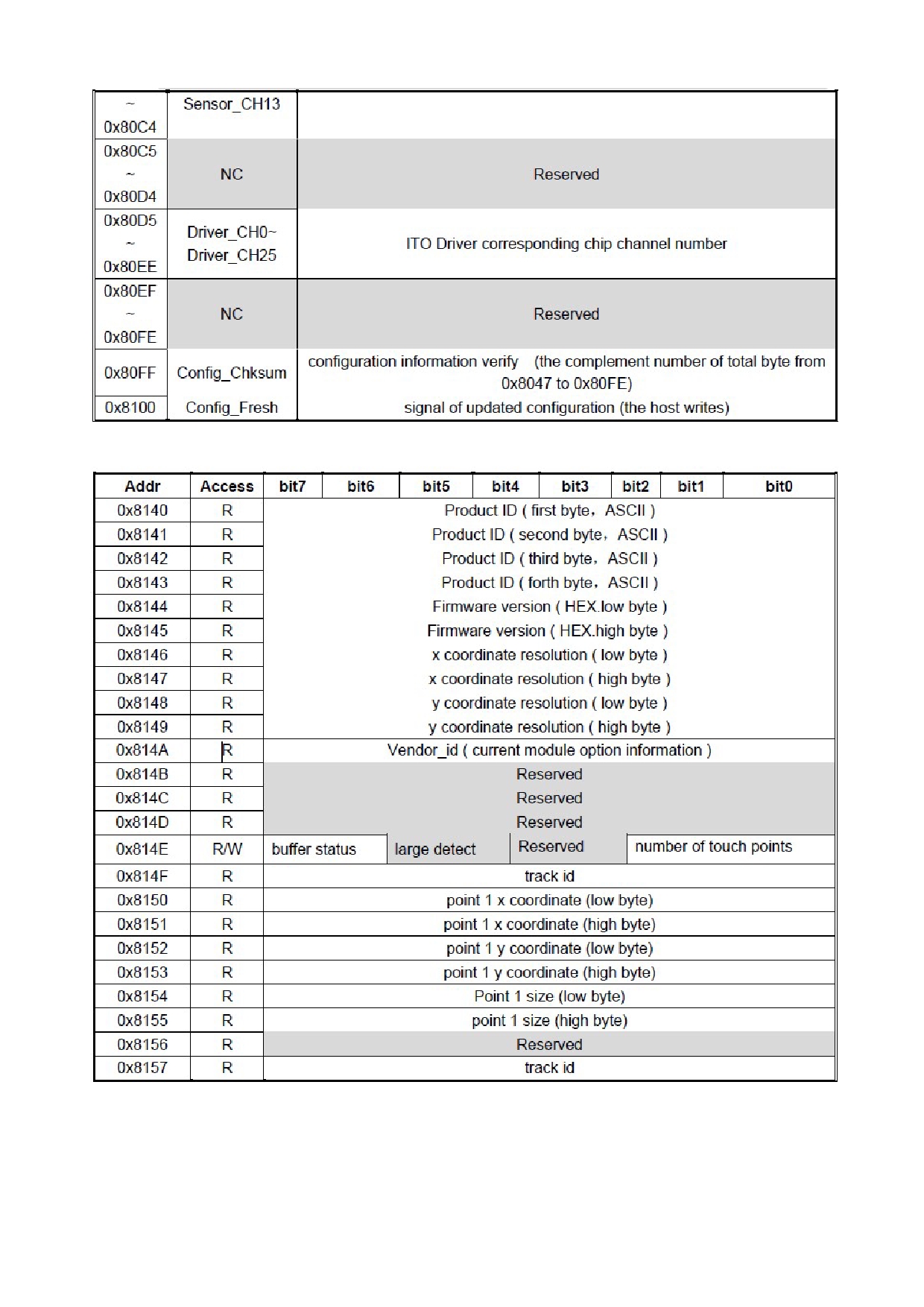
TOPWAY
LCD Module User Manual
LMT070DICFWD-NSD-2
Coordinates Information
URL: www.topwaydisplay.com
Document Name:LMT070DICFWD-NSD-2-Manual-Rev0.1.docx
Page: 15 of 22

TOPWAY
LCD Module User Manual
LMT070DICFWD-NSD-2
Note:
Please refer to GT911 IC datasheet for details.
URL: www.topwaydisplay.com
Document Name:LMT070DICFWD-NSD-2-Manual-Rev0.1.docx
Page: 16 of 22
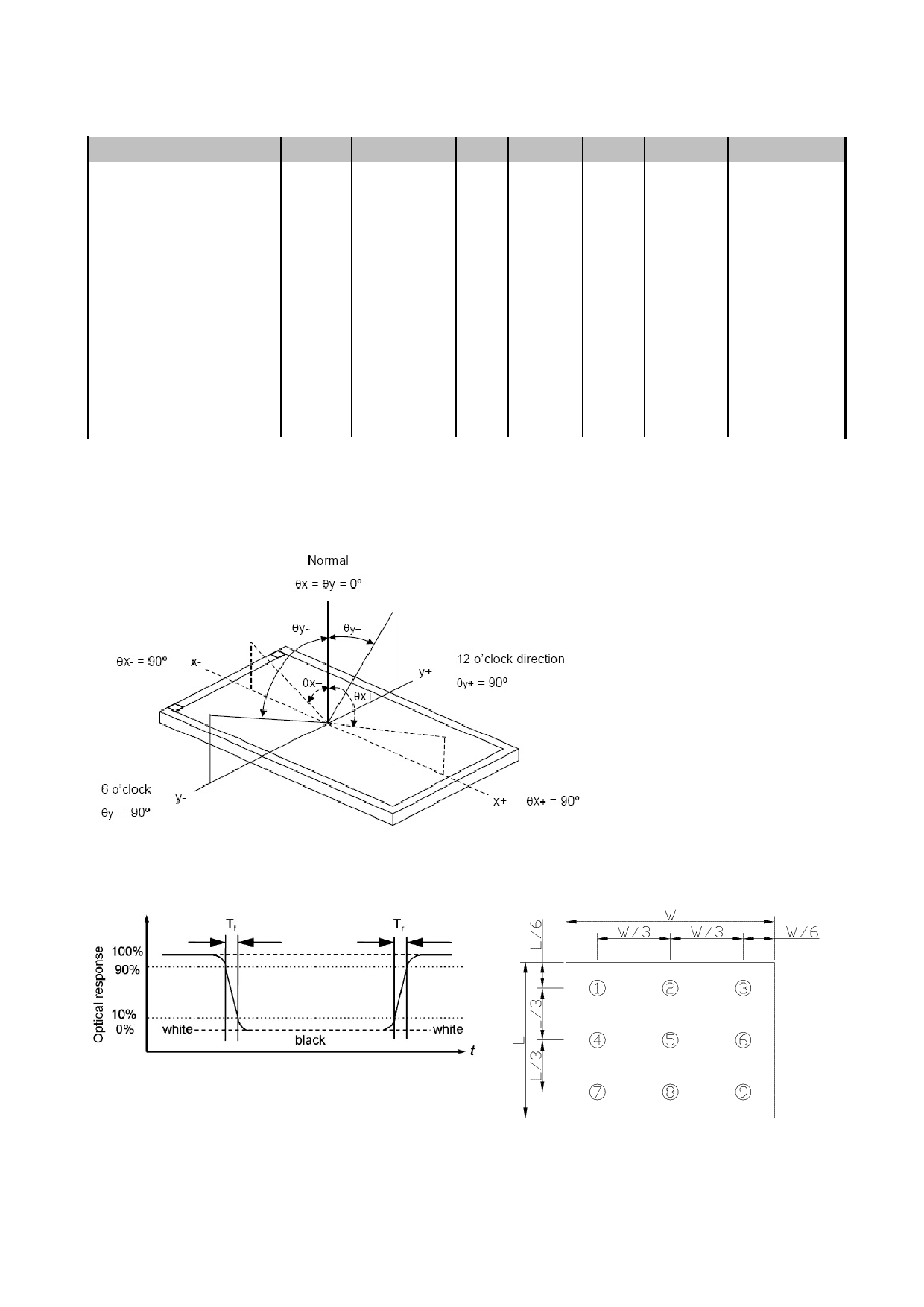
TOPWAY
LCD Module User Manual
LMT070DICFWD-NSD-2
8. Optical Characteristics
Item
Symbol
Condition
MIN.
TYP.
MAX.
UNIT
Note.
θ L
9 o’clock
60
70
-
Viewing angle
θ R
3 o’clock
60
70
-
(CR ≥ 10)
degree
*2
θ T
12 o’clock
40
50
-
θ B
6 o’clock
60
70
-
T f
-
10
20
msec
Response Time
*3
T r
-
15
30
msec
Contrast ratio
CR
400
500
-
-
Normal
W X
0.26
0.31
0.26
-
*1
Color chromaticity
θ=0 o
W Y
0.28
0.33
0.38
-
Luminance
L
-
400
-
cd/m 2
*4
Luminance uniformity
Y U
70
75
-
%
*4
Note:
*1. Definition of Contrast Ratio
The contrast ratio could be calculate by the following expression:
Contrast Ratio (CR) = Luminance with all pixels white / Luminance with all pixels black
*2 Definition of Viewing Angle
*4 Definition of Luminance Uniformity
Luminance uniformity (Lu)=
*3 Definition of response time
Min. Luminance form pt1~pt9 / Max Luminance form Pt1~pt9
URL: www.topwaydisplay.com
Document Name:LMT070DICFWD-NSD-2-Manual-Rev0.1.docx
Page: 17 of 22
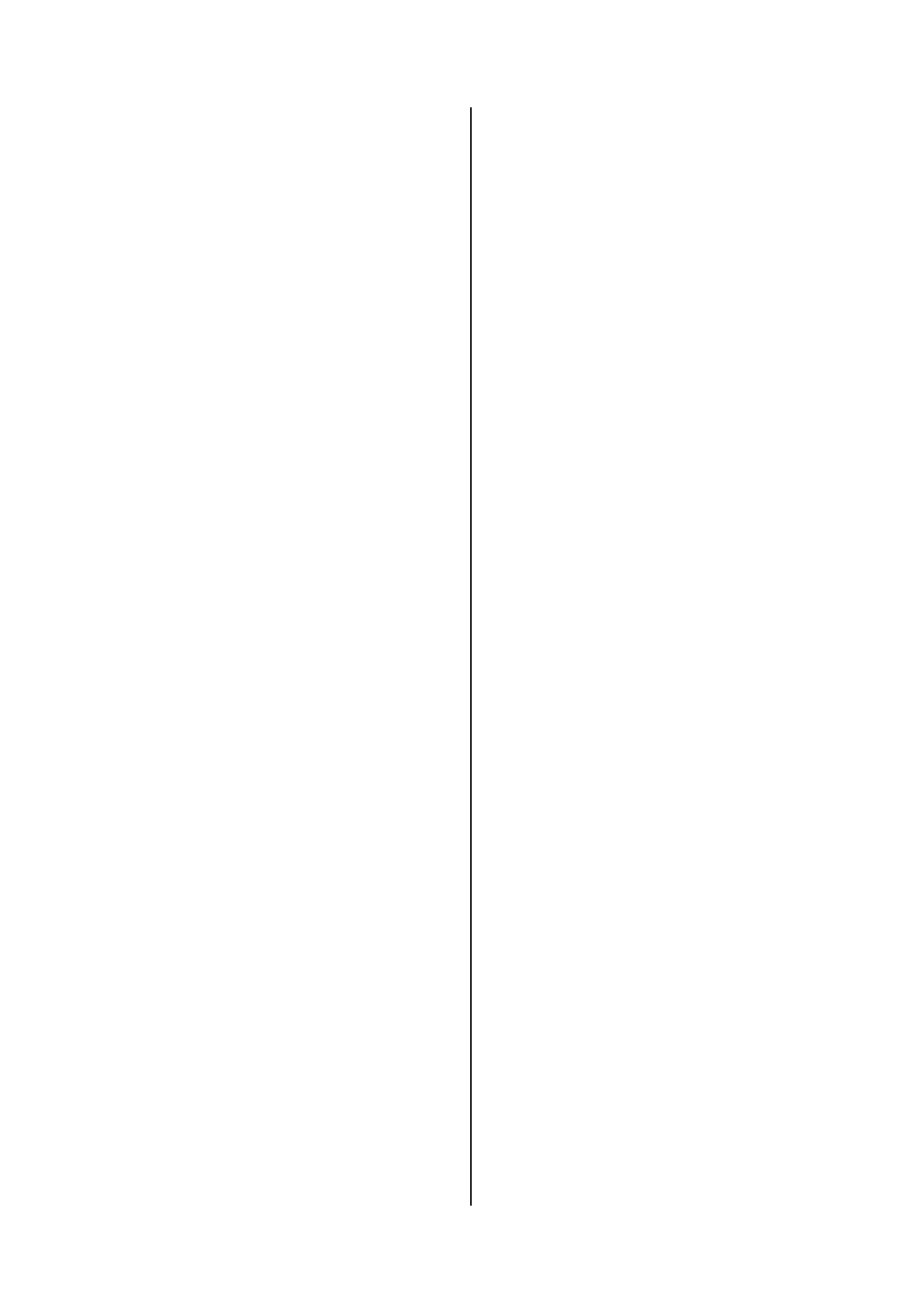
TOPWAY
LCD Module User Manual
LMT070DICFWD-NSD-2
9. LCD Module Design and
9. 液晶显示模块设计和使用须知
Handling Precautions
- Please ensure V0, VCOM is adjustable, to enable LCD
- 请注意 V0, VCOM 的设定, 以确保液晶显示模块在不同
module get the best contrast ratio under different
的使用温度下以及在不同的视角和位置观察模块显
temperatures, view angles and positions.
示,均能达到最佳对比度,请务必将应用电路上设置
- Normally display quality should be judged under the
为对比度可调。
best contrast ratio within viewable area. Unexpected - 请注意液晶显示模块的显示品质判定是指在正常对比
display pattern may com out under abnormal contrast
度下以及视窗(V.A)范围内进行的,非正常对比度下液
ratio.
- Never operate the LCD module exceed the absolute
晶可能会出现非预期的显示不良,应注意区分。
maximum ratings.
- 请勿在最大额定值以外使用液晶显示模块。
- Never apply signal to the LCD module without power
supply.
- 请勿在没有接通电源的条件下,给液晶显示模块输送
- Keep signal line as short as possible to reduce external
信号。
noise interference.
- 请尽可能缩短信号线的连接,以避免对液晶显示模块
- IC chip (e.g. TAB or COG) is sensitive to light. Strong
的信号干扰。
light might cause malfunction. Light sealing structure
- 集成电路因 IC 芯片(如 TAB 或 COG)对紫外线极为敏
casing is recommended.
感,强光环境下可能会引起液晶显示模块功能失效,
- Make sure there is enough space (with cushion)
故应采用不透光的外壳。
between case and LCD panel, to prevent external force - 请在液晶显示模块与外壳之间保留足够的空间(可使用
passed on to the panel; otherwise that may cause
衬垫),以缓冲外力对液晶显示模块的损坏或因受力不
damage to the LCD and degrade its display result.
- Avoid showing a display pattern on screen for a long
均而产生的显示不匀等异常现象。
time (continuous ON segment).
- 避免液晶显示屏在某一画面下长时间点亮,否则有出
- LCD module reliability may be reduced by temperature
现残影的风险;请通过软件每隔一段时间改变一次画
shock.
- When storing and operating LCD module, avoids
面。
exposure to direct sunlight, high humidity, high or low - 液晶显示模块的可靠性可能因温度冲击而降低。
temperature. They may damage or degrade the LCD - 请勿在阳光直射、高湿、高温或低温下储存和使用液
module.
晶显示模块,这将造成液晶显示模块的损坏或失效。
- Never leave LCD module in extreme condition
(max./min storage/operate temperature) for more than
48hr.
- 请勿在极限环境(最大/最小存储/工作温度)下使用或
- Recommend LCD module storage conditions is
放置液晶显示模块超过 48 小时以上。
0 C~40 C <80%RH.
- 液晶显示模块建议存储条件为: 0 C~40 C <80%RH 。
- LCD module should be stored in the room without acid,
alkali and harmful gas.
- 请勿让液晶显示模块存储于带有 酸性, 碱性, 有害气
- Avoid dropping & violent shocking during
体环境之中。
transportation, and no excessive pressure press, - 在运输过程中, 请勿让液晶显示模块跌落与猛烈震动,
moisture and sunlight.
同时避免 异常挤压, 高湿度, 与阳光照射.
- LCD module can be easily damaged by static
electricity. Please maintain an optimum anti-static
- 液晶显示模块极易受静电损坏,请务必保证液晶显示
working environment to protect the LCD module. (eg.
模块在防静电的工作环境中使用或保存。(如: 烙铁正
ground the soldering irons properly)
确接地,等)
- Be sure to ground the body when handling LCD
- 拿取液晶显示模块时需注意操作人员的接地情况。
module.
- Only hold LCD module by its sides. Never hold LCD
- 请手持液晶显示模块的边沿取放模块,防止热压纸或
module by applying force on the heat seal or TAB.
TAB 部位受力。
- When soldering, control the temperature and duration
- 焊接液晶模块时,请注意控制烙铁的温度、焊接时
avoid damaging the backlight guide or diffuser which
间,以免烫坏导光板或偏光片,导致显示不匀等不良
might degrade the display result such as uneven
display.
现象发生。
- Never let LCD module contact with corrosive liquids, - 请勿使用洗板水等腐蚀性液体接触液晶模块,以免腐
URL: www.topwaydisplay.com
Document Name:LMT070DICFWD-NSD-2-Manual-Rev0.1.docx
Page: 18 of 22

TOPWAY
LCD Module User Manual
LMT070DICFWD-NSD-2
which might cause damage to the backlight guide or
蚀导光板或模块电路。
the electric circuit of LCD module.
- Only clean LCD with a soft dry cloth, Isopropyl Alcohol
or Ethyl Alcohol. Other solvents (e.g. water) may
- 仅可使用柔软的干布, 异丙醇或乙醇清洁液晶屏表
damage the LCD.
面,其他任何溶剂(如:水)都有可能损坏液晶模块。
- Never add force to components of LCD module. It may
- 请勿挤压液晶显示模块上的元器件,以避免产生潜在
cause invisible damage or degrade the module's
的损坏或失效而影响产品可靠性。
reliability.
- When mounting LCD module, please make sure it is
- 装配液晶显示模块时,请务必注意避免液晶显示模块
free from twisting, warping and bending.
的扭曲或变形。
- Do not add excessive force on surface of LCD, which
- 请勿挤压液晶显示屏表面,这将导致显示颜色的异
may cause the display color change abnormally.
常。
- LCD panel is made with glass. Any mechanical shock
(e.g. dropping from high place) will damage the LCD
- 液晶屏由玻璃制作而成,任何机械碰撞(如从高处跌
module.
落)均有可能损坏液晶显示模块。
- Protective film is attached on LCD screen. Be careful - 液晶屏表面带有保护膜, 揭除保护膜时需要注意可能
when peeling off this protective film, since static
产生的静电。
electricity may be generated.
- 因液晶显示屏表面的偏光片极易划伤,安装完成之前
- Polarizer on LCD gets scratched easily. If possible, do
请尽量不要揭下保护膜。
not remove LCD protective film until the last step of - 请缓慢揭除保护膜,在此过程中液晶显示屏上可能会
installation.
产生静电线,此为正常情况,可在短时间内消失。
- When peeling off protective film from LCD, static
charge may cause abnormal display pattern. The - 请注意避免被液晶显示屏的边缘割伤。
symptom is normal, and it will turn back to normal in a - 请不要试图拆卸或改造液晶显示模块。
short while.
- 当液晶显示屏出现破裂, 内部液晶液体可能流出; 相
- LCD panel has sharp edges, please handle with care.
关液体不可吞吃, 绝对不可接触嘴巴, 如接触到皮肤
- Never attempt to disassemble or rework LCD module.
或衣服, 请使用肥皂与清水彻底清洗.
- If display panel is damaged and liquid crystal
substance leaks out, be sure not to get any in your
mouth, if the substance comes into contact with your
skin or clothes promptly wash it off using soap and
water.
10. 电容触摸屏安装指导
10.CTP Mounting Instructions
10.1 面框安装(附图 1)
- 客户面框窗口应大于 CTP 动作区域,各边离动作区应
10.1 Bezel Mounting (Figure 1)
≥0.5mm.
- The bezel window should be bigger than the CTP
- 面框与 CTP 面板间应垫有胶垫,其最终间隙约为 0.5~
active area. It should be ≥ 0.5mm each side.
1.0mm.
- Gasket should be installed between the bezel and the
- 建议必要时在背面提供附加支架(例如无安装结构的薄
CTP
surface.
型 TFT 模块),应仅利用适当支撑以保持模块位置.
The final gap should be about 0.5~1.0mm.
- It is recommended to provide an additional support
bracket for backside support when necessary (e.g. slim
- 安装结构应具有足够的强度,以防止外部不均匀力或
type TFT module without mounding structure). They
扭曲力作用到模块上.
should only provide appropriate support and keep the
module in place.
- The mounting structure should be strong enough to
prevent external uneven force or twist act onto the
module.
Figure
URL: www.topwaydisplay.com
Document Name:LMT070DICFWD-NSD-2-Manual-Rev0.1.docx
Page: 19 of 22
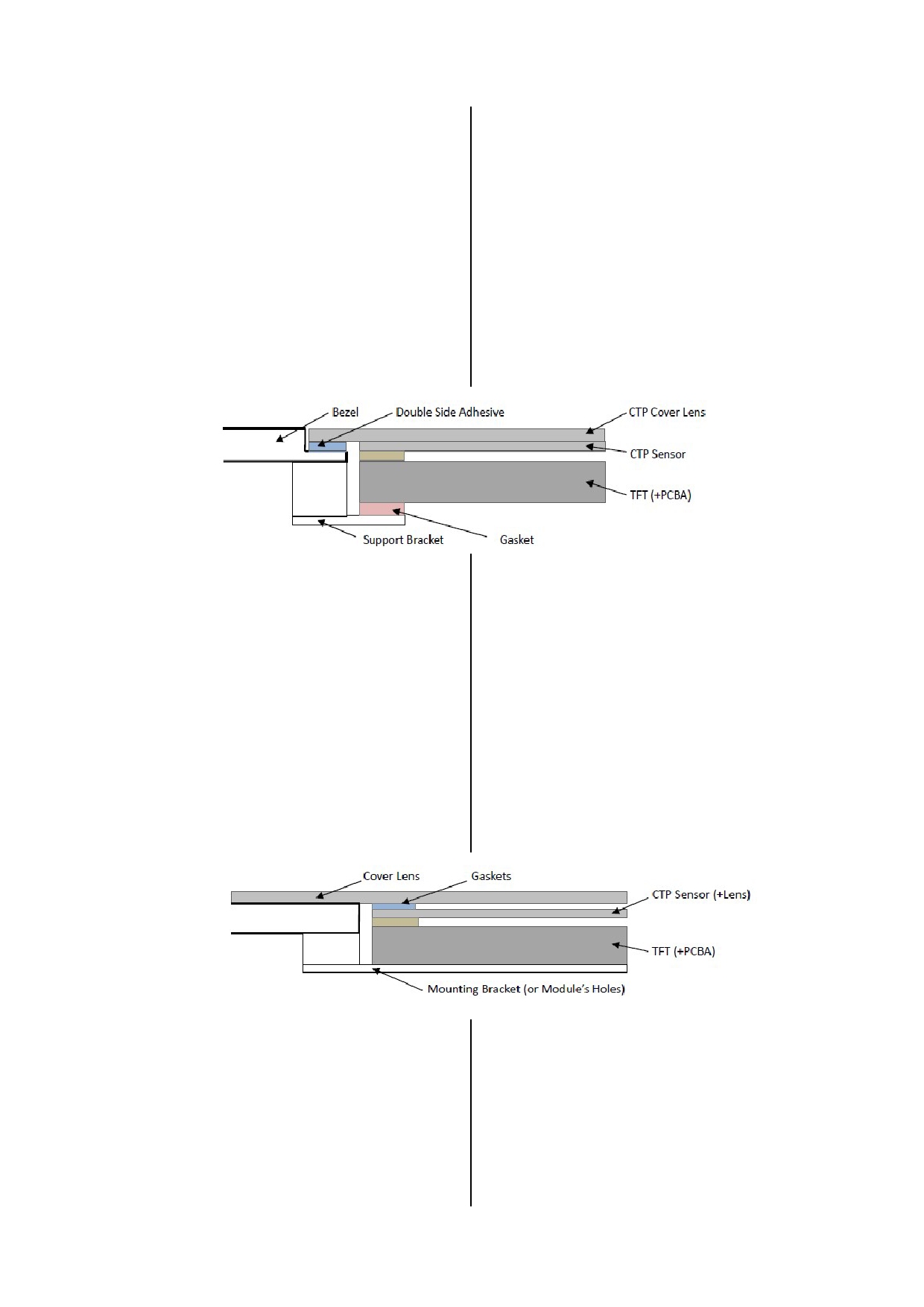
TOPWAY
LCD Module User Manual
LMT070DICFWD-NSD-2
1
10.2 Surface Mounting (Figure 2)
10.2 嵌入安装(附图 2)
- As the CTP assembling on the countersink area with - 客户面框应具有使用双面胶粘贴 CTP 的结构沉台面,
double
side
adhesive.
其粘贴面要求平整且洁净无污以保证粘贴牢靠.
The countersink area should be flat and clean to
ensure the double side adhesive installation result.
- The Bezel is recommend to keep a gap ( ≥ 0.3mm each - 考虑到制作误差,建议面框与 CTP 盖板之间四周留有
side) around the cover lens for tolerance.
≥0.3mm 间隙.
- It is recommended to provide an additional support - 建议必要时在背面提供垫有胶垫附加支架(例如无安装
bracket with gasket for backside support when
结构的 TFT 模块),应仅利用适当支撑以保持模块位
necessary (e.g.
TFT module without mounding
置.
structure). They should only provide appropriate
support and keep the module in place.
- 安装结构应具有足够的强度,以防止外部不均匀力或
- The mounting structure should be strong enough to
扭曲力作用到模块上。
prevent external uneven force or twist act onto the
module
Figure 2
10.3 Additional Cover Lens Mounting (Figure 3)
10.3 覆加盖板(附图 3)
- For the case of additional cover Lens mounting, it is - 需要覆加玻璃盖板的安装,为确保其功能,有必要查
necessary to recheck with the CTP specification about
看产品规格书中有关盖板材料和厚度的说明.
the material and thickness to ensure the functionality.
- It should keep a 0.2~0.3mm gap between the cover - 玻璃盖板与 CTP 表面之间应留有 0.2~0.3mm 间隙.
lens and the CTP surface..
- The cover lens window should be bigger than the - 玻璃盖板视窗应大于 CTP 动作区域,各边离动作区应
active area of the CTP.It should be ≥ 0.5mm each side.
≥0.5mm。
- It is recommended to provide an additional support - 建议必要时在背面提供附加支架(例如无安装结构的薄
bracket for backside support when necessary (e.g. slim
型 TFT 模块),应仅利用适当支撑以保持模块位置.
type TFT module without mounding structure). They
should only provide appropriate support and keep the
module in place.
- 安装结构应具有足够的强度,以防止外部不均匀力或
- The mounting structure should be strong enough to
扭曲力作用到模块上.
prevent external uneven force or twist act onto the
module.
Figure 3
11.RTP Mounting Instructions
11. 电阻触摸屏安装指导
- It should bezel touching the RTP Active Area (A.A.) to
- 为避免面框直接压在动作区(A.A.)上造成误动作,面框
prevent abnormal touch.It should left gab
与电阻触摸屏(RTP)之间应留有一定的空隙
D=0.2~0.3mm in between. (Figure 4)
D=0.2~0.3mm 之间.(附图 4)
- Outer bezel design should take care about the area
- 设计面框时,要注意用面框保护触摸屏四周的非保证操
outside the A.A. Those areas contain circuit wires
作区域,因为布线区域在此处形成一台阶,在此区域
which is having different thickness. Touching those
附近操作时 ITO Film 变形较大,容易导致 ITO 损坏而
areas could de-form the ITO film. As a result bezel the
降低寿命。为保护 RTP 和避免误操作,在 RTP 与面框
URL: www.topwaydisplay.com
Document Name:LMT070DICFWD-NSD-2-Manual-Rev0.1.docx
Page: 20 of 22
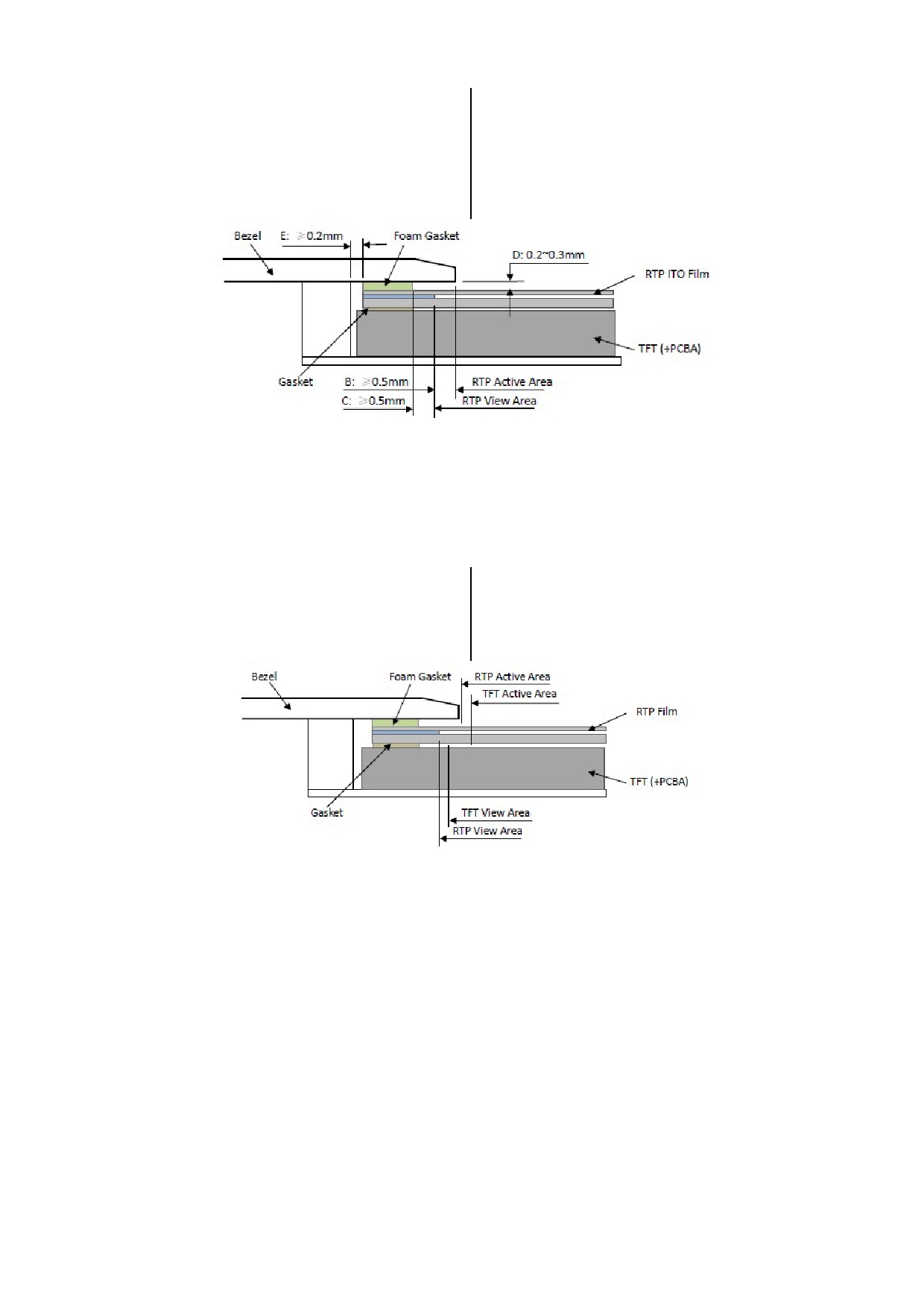
TOPWAY
LCD Module User Manual
LMT070DICFWD-NSD-2
ITO film be damaged and shorten its lifetime.
之间垫缓冲物(Gasket),我们建议设计面框应覆盖
It is suggested to protect those areas with gasket
动作区的边缘,面框边缘到 V.A.区的距离 B≥0.50mm;
(between the bezel and RTP).The suggested figures
垫圈内边缘到 V.A.区的距离 C≥0.50mm. (附图 4)
are B≥0.50mm; C≥0.50mm. (Figure 4)
- The bezel side wall should keep space E= 0.2 ~ 0.3mm - 在设计面框与 RTP 组装时,应考虑到面框内侧与 RTP 外
from the RTP. (Figure 4)
侧的间距 E≥0.2mm. (附图 4)
Figure 4
- In general design,
- 通常设计时:
RTP V.A. should be bigger than the TFT V.A.
RTP 的可视区 V.A. 应不小于 TFT 的可视区 V.A.
and RTP A.A. should be bigger than the TFT A.A.
及 RTP 的动作区 A.A. 应不小于 TFT 的动作区 A.A.
(Figure 5)
(附图 5)
Figure 5
URL: www.topwaydisplay.com
Document Name:LMT070DICFWD-NSD-2-Manual-Rev0.1.docx
Page: 21 of 22

TOPWAY
LCD Module User Manual
LMT070DICFWD-NSD-2
12.Warranty
This product has been manufactured to our company’s specifications as a part for use in your company’s general
electronic products. It is guaranteed to perform according to delivery specifications. For any other use apart from
general electronic equipment, we cannot take responsibility if the product is used in medical devices, nuclear power
control equipment, aerospace equipment, fire and security systems, or any other applications in which there is a direct
risk to human life and where extremely high levels of reliability are required. If the product is to be used in any of the
above applications, we will need to enter into a separate product liability agreement.
- We cannot accept responsibility for any defect, which may arise form additional manufacturing of the product
(including disassembly and reassembly), after product delivery.
- We cannot accept responsibility for any defect, which may arise after the application of strong external force to the
product.
- We cannot accept responsibility for any defect, which may arise due to the application of static electricity after the
product has passed our company’s acceptance inspection procedures.
- When the product is in CCFL models, CCFL service life and brightness will vary according to the performance of the
inverter used, leaks, etc. We cannot accept responsibility for product performance, reliability, or defect, which may
arise.
- We cannot accept responsibility for intellectual property of a third part, which may arise through the application of
our product to our assembly with exception to those issues relating directly to the structure or method of
manufacturing of our product.
-
URL: www.topwaydisplay.com
Document Name:LMT070DICFWD-NSD-2-Manual-Rev0.1.docx
Page: 22 of 22
